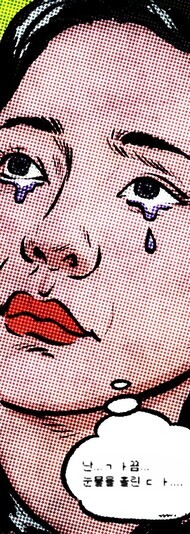hankyoreh
Links to other country sites 다른 나라 사이트 링크
[Column] Cambodian child becomes prop for S. Korea’s first lady


There is a strange tradition in Korean politics of touring areas frequented by the everyday person and participating in volunteering in an almost show-like fashion.
The president and their spouses, ministers, lawmakers — the elite of the elite visit traditional markets to exchange a few words with merchants or head to disaster recovery sites to pose with a shovel. Reporters go on to record these moments to appeal to the public by showing that the authorities do know what civilians want, and by doing so create pretty pictures that’ll appeal to many and build a good public image.
This tradition probably has its roots in “rounds” or other ritualistic acts that the monarchy used to participate in during the traditional dynastic era. Confucianism stated that monarchs and higher-ranking officials had a moral obligation to look after “the young peasants” and to see their joys and sorrows with one’s own eyes.
The visits that North Korea’s officials make to various public places — such as military barracks, factories, schools and more — are a modern version of making such rounds.
Of course, the ideology underlying these political acts is different in nature from the principles of modern democracy or equality. For instance, in a country like Norway, where egalitarianism is firmly rooted, it is perfectly natural for ministers or lawmakers to take the bus or the subway, see their children off to kindergarten, or participate in volunteering with locals. As such, no one thinks of taking pictures and releasing them to the press.
It is only in a society where it is considered unusual for a higher-up to buy things at a traditional market or to be holding a shovel that these images are considered newsworthy.
When I first saw the controversial photo of Kim Keon-hee holding a gaunt Cambodian boy suffering from heart disease in her arms, I understood this to be an international variation on the common volunteering show. Such shows are usually meant to mask what is lacking in politics, this instance serves as case and point: South Korea provides lackluster support for countries in need.
South Korea only uses around 0.16% of its gross domestic income for development aid, which is lower than that of Norway and Sweden (where it is at around 1%), as well as lower than Japan (0.34%) and Hungary (0.29%), countries that are known for being nationalistic and averse to change.
As soon as I saw the photo, I thought that it must be another pretense to hide the fact that South Korea is the stingiest among all developed countries when it comes to providing development aid.
However, the more I looked at this picture, the more uncomfortable it made me.
The public does not think favorably of politicians’ “voluntourism.” Since the volunteerism is always a one-off and lasts no more than a few hours, it does not really help those in need. Not to mention that it seems entirely insincere to pose for the camera with something like a shovel, when these politicians have hands that look like they’ve never done a day’s worth of honest labor.
However, in that picture, the first lady is holding a child, not a shovel. Should the spouse of an elected official, who goes to make diplomatic visits on taxpayer money, make a child of a foreign country a tool of a political show? If the first lady had been sponsoring the boy or the hospital in which he was getting surgery (Hebron Medical Center), that would be a different story. But without such a background, suddenly visiting an invalid’s house and posing in front of a camera with them can only be seen as politically instrumentalizing another human being.
Another problem, as many domestic and foreign observers have already pointed out, is that this overseas volunteering show seems to have used a famous photo of Dutch American actor Audrey Hepburn holding a Somali child as reference.
Using a child with a congenital heart disease as part of a premeditated plan shows more than the phoniness of many high-ranking officials and can only be seen as a deplorable lack of consciousness and ignorance. However, this can also provide a glimpse into the desires shared by many belonging to Korea’s social upper class, instead of merely stopping at being a cosplay of a famous Western actor.
Unlike the current first lady, Audrey Hepburn worked with UNICEF for many years and had her own expertise in fields such as medical aid. Hepburn’s motivation to provide humanitarian aid was also fundamentally different from that of rogue politicians who participate in facades to cover their political incompetency.
Since Hepburn suffered from starvation and malnutrition when the Netherlands was occupied by Nazi Germany during World War II, it is easy to believe in her sincerity when she said that she sympathized for the pain children in Ethiopia, Somalia, Bangladesh and Vietnam were facing.
Despite that, international philanthropy — which is usually associated with Western and white figures like Hepburn — plays an important role in misrepresenting the various origins of starvation, poverty, or pandemics, even if the individual participating means all the good in the world. It could also be said that it is used to cleanse any bad public images that those Western forces may have. This is the crux of the matter.
Countries such as South Korea, which managed to reach economic development to produce high-value-added products, or China, which now has the world’s largest real economy based on a similar model, do not need the charity of the West. Most countries that do need such charity lack the political and administrative power to urge for development, and many foreign powers, mostly from the West, dominate the mining of buried resources and low-wage, low-value-added manufacturing industries.
In all, regardless of their intention, the “good work” of philanthropists such as Hepburn plays a role in covering the ugly money-making of Western powers in neighboring countries.
Today, however, the first lady’s “cosplay” of Audrey Hepburn shows how there is no difference between South Korea’s relationship with Cambodia and that of the West and the global periphery. It also shows the Korean ruling class’s desire to enjoy playing the role of the “honorary white person.”
South Korea, which was the top investor in Cambodia 12 years ago, makes profits while exploiting the cheap labor of Cambodians both in Cambodia and domestically and tries to cover up its pursuit of excess profits by using the poverty of others with images of “charity,” similar to what white people from the West used to do.
But it’s not just the first lady doing this. Many domestic companies and religious organizations also use their charitable activities in Cambodia for publicity and to “cleanse” their image. The self-promotional act of using a sick child as an accessory particularly stands out as a symbol of shamelessness.
I'm afraid to even imagine how the locals in Cambodia feel while watching this disturbing charity show.
Please direct questions or comments to [english@hani.co.kr]

Editorial・opinion
![[Column] Park Geun-hye déjà vu in Yoon Suk-yeol [Column] Park Geun-hye déjà vu in Yoon Suk-yeol](https://flexible.img.hani.co.kr/flexible/normal/500/300/imgdb/original/2024/0424/651713945113788.jpg) [Column] Park Geun-hye déjà vu in Yoon Suk-yeol
[Column] Park Geun-hye déjà vu in Yoon Suk-yeol![[Editorial] New weight of N. Korea’s nuclear threats makes dialogue all the more urgent [Editorial] New weight of N. Korea’s nuclear threats makes dialogue all the more urgent](https://flexible.img.hani.co.kr/flexible/normal/500/300/imgdb/original/2024/0424/7317139454662664.jpg) [Editorial] New weight of N. Korea’s nuclear threats makes dialogue all the more urgent
[Editorial] New weight of N. Korea’s nuclear threats makes dialogue all the more urgent- [Guest essay] The real reason Korea’s new right wants to dub Rhee a founding father
- [Column] ‘Choson’: Is it time we start referring to N. Korea in its own terms?
- [Editorial] Japan’s rewriting of history with Korea has gone too far
- [Column] The president’s questionable capacity for dialogue
- [Column] Are chaebol firms just pizza pies for families to divvy up as they please?
- [Column] Has Korea, too, crossed the Rubicon on China?
- [Correspondent’s column] In Japan’s alliance with US, echoes of its past alliances with UK
- [Editorial] Does Yoon think the Korean public is wrong?
Most viewed articles
- 1‘We must say no’: Seoul defense chief on Korean, USFK involvement in hypothetical Taiwan crisis
- 2‘Weddingflation’ breaks the bank for Korean couples-to-be
- 3[Reportage] On US campuses, student risk arrest as they call for divestment from Israel
- 4[Column] Park Geun-hye déjà vu in Yoon Suk-yeol
- 5Amnesty notes ‘erosion’ of freedom of expression in Korea in annual human rights report
- 6Korea sees more deaths than births for 52nd consecutive month in February
- 7N. Korean delegation’s trip to Iran shows how Pyongyang is leveraging ties with Moscow
- 8Will NewJeans end up collateral damage in internal feud at K-pop juggernaut Hybe?
- 9[Guest essay] The real reason Korea’s new right wants to dub Rhee a founding father
- 10N. Korean hackers breached 10 defense contractors in South for months, police say